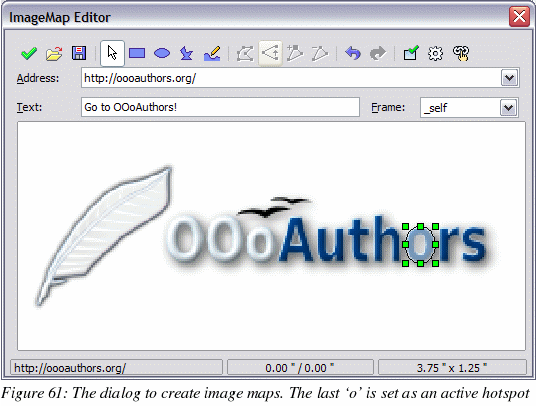Creating an image map
An
image map defines areas of the image (called hotspots)
with a URI (a web address or a file on the computer). Hotspots are
the graphic equivalent of text hyperlinks. Clicking on a hotspot
causes Impress to open the linked page in the appropriate program
(for example, the default browser for an HTML page; OOo Writer for a
.ODT file; a PDF viewer for a PDF file). You can create hotspots of
various shapes, and include several hotspots in the same image.
To use the image
map tool:
Select the picture
where the hotspots will be defined.
Choose
Edit > ImageMap
from the menu bar. The ImageMap Editor dialog (Figure 61) opens.
Use
the tools and fields in the dialog to define the hotspots and links
necessary.
Click
the Apply icon
 to apply the settings.
to apply the settings.
When
done, click the Save
icon
 to save the imagemap to a file, then click the X
in the upper right corner to close the dialog.
to save the imagemap to a file, then click the X
in the upper right corner to close the dialog.

The
top part of the dialog contains the following tools:
Apply
button: click this button to apply the changes.
Load,
Save, and Select
icons.
Tools
for drawing a hotspot shape: these tools work in exactly the same
way as the corresponding tools in the Drawing toolbar (described in
Chapter 5).
Edit,
Move, Insert,
Delete Points:
advanced editing tools to manipulate the shape of a polygon
hotspot. Select the Edit Points tool to activate the other tools.
Active
icon: toggles the status of the hotspot activating a deactive the
selected hotspot or deactivating it if active.
Macro:
associates a macro with the hotspot instead of just associating an
hyperlink.
Properties:
sets the hyperlink properties and adds the Name attribute to the
hyperlink.
Below the toolbar,
specify for the selected hotspot:
Address:
the address pointed by the hyperlink. You can also point to an
anchor in a document such as a specific slide number; to do this,
write the address in this format:
file:///<path>/document_name#anchor_name
Text:
enter the text that will be displayed when the mouse is moved over
the hotspot.
Frame:
where the target of the hyperlink will open: pick among _blank
(opens in a new browser window), _self (opens in the active browser
window), _top or _parent.
|
Tip
|
The
value _self for the target frame will work just fine in the vast
majority of the occasions. It is therefore not recommended to use
the other values unless absolutely necessary.
|
The
main part of the dialog shows the image on which the hotspots will
be defined and the hotspot itself. Note that an active hotspot is
indicated by a white shading, while an inactive hotspot is
identified by a red border but no shading.
